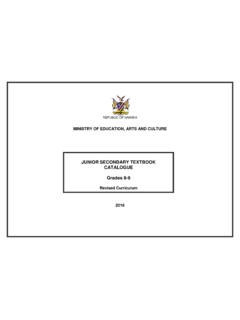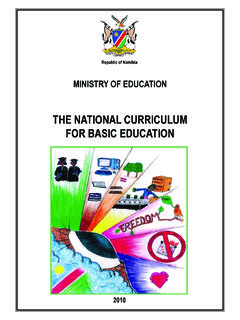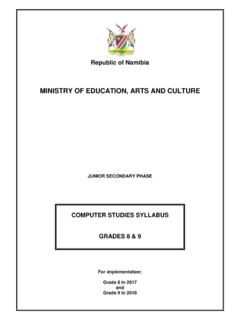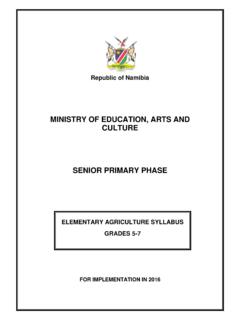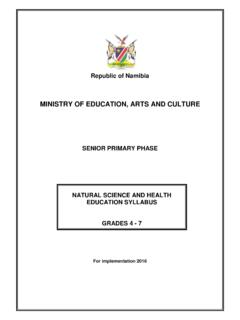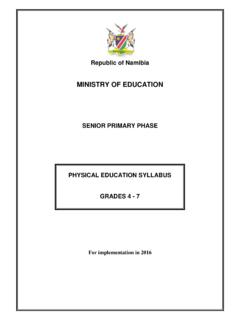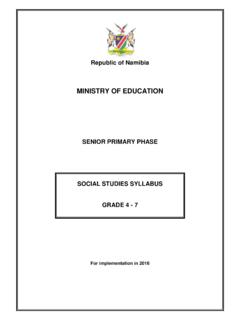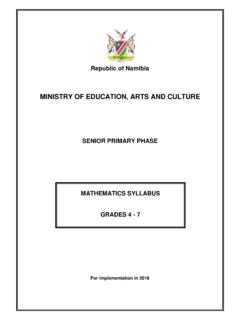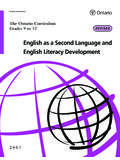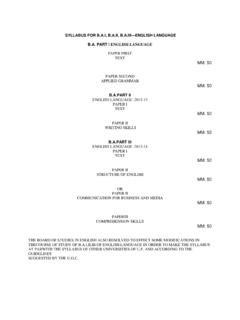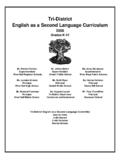Transcription of MINISTRY OF EDUCATION NAMIBIA SENIOR …
1 Republic of NAMIBIA MINISTRY OF EDUCATION NAMIBIA SENIOR secondary certificate (NSSC) 2010 DEVELOPED IN COLLABORATION WITH UNIVERSITY OF CAMBRIDGE INTERNATIONAL EXAMINATIONS english second language SYLLABUS ORDINARY LEVEL SYLLABUS CODE: 4116 GRADES 11 - 12 Republic of NAMIBIA MINISTRY OF EDUCATION NAMIBIA SENIOR secondary certificate (NSSC) english second language SYLLABUS ORDINARY LEVEL This Syllabus Replaces Previous NSSC syllabuses and will be implemented in 2010 inGrade11 MINISTRY of EDUCATION National Institute for Educational Development (NIED) Private Bag 2034 Okahandja NAMIBIA Copyright NIED, MINISTRY of EDUCATION , 2009 NSSCO english second language Syllabus for Grades 11&12 ISBN: 99916-58-80-7 Printed by NIED Publication date: 2009 TABLE OF CONTENTS 1.
2 Introduction .. 1 2. Rationale .. 2 3. Aims .. 2 4. Overview of Learning Content .. 3 General .. 3 Textbooks and Resources .. 3 5. Learning Content .. 9 Listening .. 4 Speaking .. 6 Reading .. 8 Writing .. 10 language Usage .. 12 6 Assessment .. 14 Assessment Objectives .. 14 Scheme of Assessment .. 14 Marks and Weighting Of Papers .. 14 Description of Papers .. 15 Specification Grid .. 18 7. Grade Descriptions .. 19 8. Glossary of Terms .. 21 Addendum A: Notes on Conducting Oral Tests .. 22 Addendum B: Marking Grid for Oral Assessment (Paper 4) .. 26 Addendum C: Marking Grid for Written Work (Paper 1 & 2) .. 27 NSSCO english 2nd language Syllabus, NIED 2009 11. INTRODUCTION The NAMIBIA SENIOR secondary certificate Ordinary Level (NSSCO) is designed as a two-year course for examination after completion of the Junior secondary certificate .
3 The syllabus is designed to meet the requirements of the National Curriculum for Basic EDUCATION in NAMIBIA and has been approved by the National Examination, Assessment and Certification Board (NEACB). The main sections are: Aims Learning Content Assessment Grade Descriptions As part of life-long learning, the National Curriculum Guidelines, applicable to SENIOR secondary EDUCATION , recognise the uniqueness of the learner and adhere to the philosophy of learner-centred EDUCATION . The NAMIBIA National Curriculum Guidelines aim to: recognise that learning involves the development of values and attitudes as well as knowledge and skills; promote self-awareness and an understanding of the attitudes, values and beliefs of others in a multilingual and multicultural society; encourage respect for human rights and freedom of speech; provide insight and understanding of crucial global issues in a rapidly changing world which affect quality of life: the AIDS pandemic; global warming; environmental degradation; mal-distribution of wealth; expanding and increasing conflicts; the technological explosion and increased connectivity.
4 Recognise that as information in its various forms becomes more accessible learners need to develop higher cognitive skills of analysis, interpretation and evaluation to use the information effectively; challenge and motivate learners to reach their full potential and to contribute positively to the environment, economy and society. Thus the Namibian National syllabi should provide opportunities for developing essential/core skills across the various fields of study. Such skills cannot be developed in isolation and they may differ from context to context according to the field of study. language contributes directly to the development of the six core skills marked *. Communication Skills * Numeracy Skills Information Skills* Problem-solving Skills* Self-management and Competitive Skills* Social and Co-operative Skills* Physical Skills Work and Study Skills* NSSCO english 2nd language Syllabus, NIED 2009 22.
5 RATIONALE As the national official language of NAMIBIA , english occupies an important position in the citizen s life. This is reflected in the position of english as one of the compulsory subjects in the curriculum. Through the curriculum and the efforts of the teachers, the Namibian EDUCATION system must meet its constitutional obligation to ensure proficiency in the official language . language stimulates personal growth and assists in the development of general knowledge, attitudes, critical abilities, moral values, and the aesthetic sense. This potential is enhanced by the rich and varied heritage of literary and scholarly work that has accumulated in english . Among Namibians english will operate as one of the most important languages of national unity and identity by virtue of it being the one language all Namibian learners will study. In the wider sphere it is a language of access to the international community and a worldwide information network.
6 3. AIMS The aims of the syllabus are the same for all learners. They are set out below and describe the educational purpose of a course in english as a second language for the Ordinary Level examination. They are not listed in order of priority. The aims are to enable learners to: develop the ability to use english effectively, accurately and appropriately for the purpose of practical communication in speech and writing; understand and respond appropriately to what they hear, read and experience; enjoy and appreciate the variety of language ; enjoy the reading of literature and explore areas of universal human concern; form a sound base for the skills required for further study or employment using english as the medium; develop an awareness of the nature of language and language -learning skills; NSSCO english 2nd language Syllabus, NIED 2009 34.
7 OVERVIEW OF LEARNING CONTENT (See paragraphs to for more detail) GENERAL The Learning Content is the same for all learners. The Learning Content in english as a second language has been grouped according to the five skill areas tested by the examination. Therefore the content is listed under the columns Skills, Objectives and Competencies. The integration of Reading and Writing and Listening and Speaking is considered desirable in order to reflect the way in which language is actually used. Note: Although language Usage had been listed as a separate skill in this document it should be taught in accordance with the practice of teaching language in an integrated way. Listening Speaking Reading Writing language Usage TEXTBOOKS AND RESOURCES Although literature is not formally assessed in the NSSCO curriculum, it forms part of the reading programme for learners and teachers have to include poetry, prose and drama in their choice of texts.
8 Teachers may consult the Textbook Catalogue for suitable literary texts. In their choice of reading texts teachers should consider the background knowledge, age and interests of their learners as well as suitability of the texts to learners. The Textbook Catalogue is a viable source of approved titles to choose from. Schools may also use textbooks previously listed in the Textbook Catalogue but which do not appear anymore. Examples of other viable sources teachers may wish to use are newspapers, magazines, listening cassettes and CD s, dictionaries, encyclopaedia and the Internet. NSSCO english 2nd language Syllabus, NIED 2009 45. LEARNING CONTENT LISTENING SKILLS OBJECTIVES Learners will: COMPETENCIES Learners should be able to: 1.
9 Listening listen to and understand a range of texts demonstrate understanding of specific details, information and semiformal announcements, lessons, talks, news, radio broadcasts, interviews, dialogues, stories, weather forecasts, songs, schedules, poems, travel, telephone conversations. 2. Carrying out instructions listen to and understand instructions identify and interpret key words in instructions, such as: - compare - discuss - define - contrast - name demonstrate understanding of oral instructions in class and examinations follow directions 3. Active listening listen actively to information for a variety of purposes listen for pleasure and enjoyment (poems, short stories, etc.) demonstrate understanding identify sequence identify cause and effect use and apply information heard interpret and synthesise information (such as establishing similarities and differences, advantages and disadvantages) predict likely outcomes in spoken texts use information heard to complete a task take notes from oral texts 4.
10 Comprehension distinguish between different types of questions and respond appropriately respond to both objective and open-ended questions appropriately respond to yes or no questions and question tags appropriately respond precisely and relevantly to questions that require further information recognise rhetorical questions respond appropriately to various texts and - make informed decisions based on information heard NSSCO english 2nd language Syllabus, NIED 2009 LISTENING (continued) SKILLS OBJECTIVES Learners will: COMPETENCIES Learners should be able to: 4. Comprehension (continued) understand information from a variety of sources for specific purposes use style and register suited to task form an opinion based on what is heard draw conclusions from and identify the relationship between ideas within the material that has been heard compare and contrast material report on oral material demonstrate general comprehension of the speaker s intentions where appropriate show awareness of major variations in register 5.

